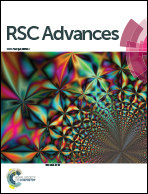Coumarin functionalized thiocarbonohydrazones as a new class of chromofluorescent receptors for selective detection of fluoride ion†
Abstract
Two chromofluorescent thiocarbonohydrazone receptors (4 and 5) functionalized with coumarin derivatives have been synthesized and evaluated for selective detection of fluoride ions. Receptor 4 selectively recognizes fluoride ions via H-bond interaction and subsequent deprotonation to elicit a distinct visual colour change from colourless to pink with a significant 20-fold enhancement in its emission intensity to “turn on” a blue fluorescent. In contrast, receptor 5 exhibited a visible colour change from colourless to deep red upon interaction with fluoride ions over other anions. Detailed analysis of the binding characteristics of these receptors with fluoride ions revealed a 1 : 1 binding stoichiometry at lower concentrations while higher concentrations led to a 1 : 2 binding stoichiometry between the receptor and fluoride ions. These experimental results were further corroborated with quantum chemical calculations.


 Please wait while we load your content...
Please wait while we load your content...